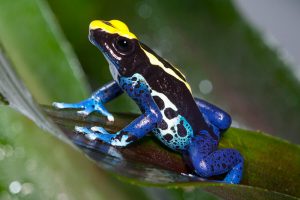In the new paper, the researchers studied poison frogs in the genus Phyllobates that employ a toxin
called batrachotoxin, which works by disrupting the transport of sodium ions in and out of cells — one of the
most important physiological functions in the body. When your brain sends signals to the body, it sends them
via electricity. These signals carry instructions to parts of the body, for example to your limbs to tell them
to move, to muscles to tell them to contract, and to the heart to tell it to pump. These electrical signals
are made possible b
y the flow of positively charged ions, such as sodium, into negatively charged cells. Ions flow in and out
of cells via protein doors called ion channels. When these ion channels are disrupted, electrical signals can’t
travel through the body.
Batrachotoxin
Batrachotoxin causes the ion channels to stay open, resulting in a freely-flowing stream of positively
charged ions into cells, Abderemane-Ali told Live Science. If those are unable to close, the entire system
loses its ability to transmit electrical signals.
Poisonous Frogs

So how do these frogs, and other poisonous animals, avoid suffering the same fate? There are
three strategies poisonous animals use to stop autointoxication, Abderemane-Ali said. The most
common involves a genetic mutation that slightly changes the shape of the toxin’s target protein —
the sodium-ion door — so that it can no longer bind to the protein. For example, a species of poison
frog called Dendrobates tinctorius azureus carries a toxin called epibatidine that mimics a beneficial
signaling chemical called acetylcholine. According to a 2017 study published in the journal Science,
so these frogs evolved adaptations in their acetylcholine receptors that slightly changed the shape of those receptors, making them resistant to the toxin.
Another strategy, used by predators of poisonous animals, is the ability to get rid of the toxin from the
body entirely, Abderemane-Ali said. This process isn’t necessarily the same as avoiding autointoxication,
it’s just another way that animals avoid being poisoned by things they eat.
“We need these channels to open and close to generate electricity that runs our brain or heart muscles,” Abderemane-Ali said. If the channels just stay open, “there is no cardiac activity, there is no neuronal
activity or contractive activity.”
Basically, if you ingest one of these frogs, you die — almost immediately.
sequestration
The third strategy is called “sequestration.”
“The animal will develop systems to capture [or] to soak up the toxin to make sure that it does not cause
problems to the animal,” Adberemane-Ali said.
In Adberemane-Ali’s study, he cloned sodium-ion channels from Phyllobates frogs and treated them
with the toxin. He was surprised to see that the sodium-ion channels were not resistant to the toxin.
“These animals should be dead,” Abderemane-Ali said. Because the frogs’ sodium-ion channels did not
resist the toxin’s disruptive effects, so the frogs shouldn’t be able to survive with this toxin in their bodies.
Based on those results, Abderemane-Ali suspects that these frogs are most likely employing the
sequestration strategy of avoiding autointoxication by using something he calls a “protein sponge.”
The frogs likely produce a protein that can sop up the toxin and hold onto it, so meaning the toxin never has
a chance to reach those vulnerable protein channels in the first place.
Credits:livescience.com











